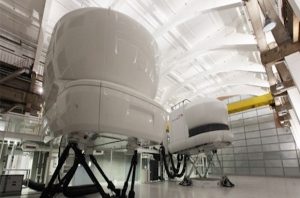What video game could ever compare with manning the controls of a multi-million dollar flight simulator? It's worth flying to London just to experience if only once.
These sophisticated, multi-million dollar machines rest on articulated mechanical legs that, as the name implies, simulate flight for pilot training (from the outside, they look like something out of Star Wars). They're identical to a real cockpit in every detail, and the windows are actually video screens that can be programmed to show airport terminals, taxiways, runways, topographical features, and weather conditions. The pods tilt, lurch and even rumble to recreate real-life conditions, and speakers broadcast sounds (jet and wind noise, landing gear and flap movement, the thud of landing, even the sound of the tires bumping along the taxiway).
I took my sheepskin-upholstered seat and after watching a typical take off and landing performed by my instructor, an experienced BA captain, it was my turn. Where would I like to go? Tokyo? Manhattan? Hong Kong? A technician set the computer to Tokyo. I released the brakes, and we were “towed” out to the taxiway and I slowly positioned the aircraft for take off. The joystick responded to only the slightest movements, and had this been an actual taxi someone on the ground would have assumed I was inebriated. Once on the runway, I applied the brakes and then placed my right hand on the four throttle levers, pushing them forward in unison. As we ascended, the simulator tilted and banked. (In fact, the motion was so real that after a few such take offs a colleague became airsick.)
The software had been programmed for a bright sunny day, but with a quick adjustment the “weather” could be switched to turbulent, cloudy, or rainy. And yes, simulated windshield wipers switched on when the simulated rain started “pelting” our craft, complete with sound effects.
Had my instructor wished, he could have put another jet in my path, caused an engine failure or other emergency. But I had all I could do managing normal conditions.
In minutes, we were descending into Hong Kong, my first port of call. It wasn’t exactly a smooth landing. I was more successful upon subsequent approaches at New York’s JFK and LAX.
There’s no such thing as a completely automated take off or landing, I learned, even when using the autopilot. Planes do not actually take off and land by themselves, much less position themselves for take off, or bring themselves to the gate. At the very least you have to lower the landing gear, but there are many other manual operations required.
Wow. The two hours passed in a flash and all too soon I returned to Earth, literally and figuratively. I’d do it again and again, given the chance.
The British Airways website describes the airline’s flight simulator experiences as “the thrill of a lifetime” and that’s no exaggeration. Currently, simulator flights are available on Boeing 747-400, Boeing 757-200, and Boeing 767-300 sims (training on the Airbus A380 and other models in the fleet may become available in the future). A one-hour “flight” costs £399 (about $440) or £1197 (about $1700) for a three-hour flight. Gift certificates are available as well. I can’t think of a better present for anyone who ever dreamed of being a pilot. And I hope this won't be my only chance to play pilot for a few hours.
For more info on flight simulator bookings, visit British Airways.






